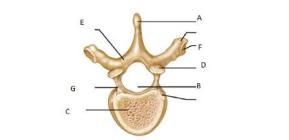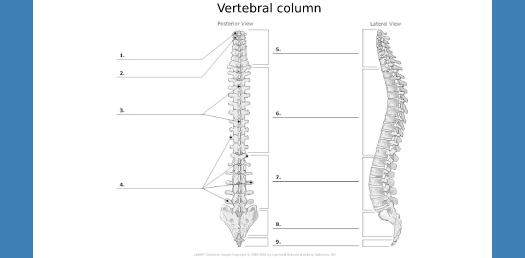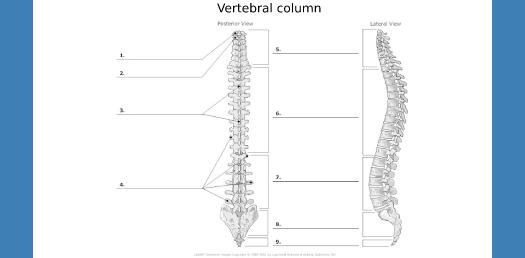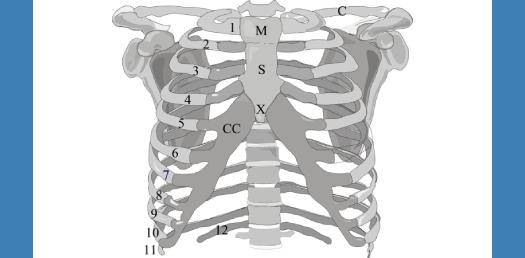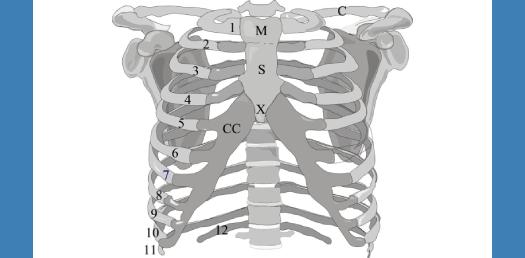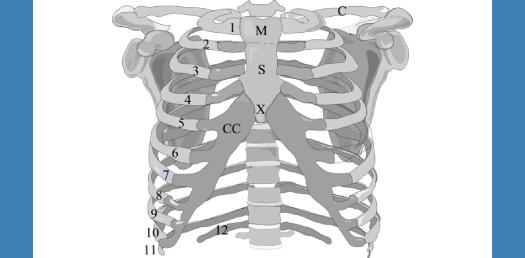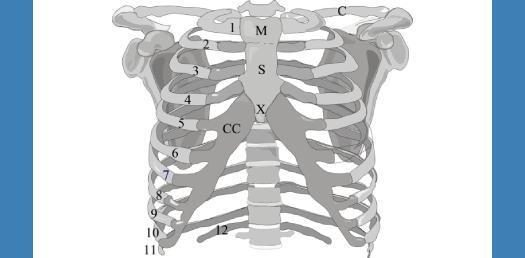Skeletal Insights: Vertebral Column And Rib Cage Quiz
(35).jpg)
Hi there, welcome to this quick quiz on the vertebral column and rib cage, which must be called the armor of the mid-upper body because it not only lets our lungs and heart stay still in a particular position but also protects it from outer pressure.
Whether you're a student diving into anatomy or a curious learner, test your knowledge and unravel the secrets of this vital skeletal framework. Embark on a journey of discovery and enhance your understanding of the vertebral column and rib cage's intricate anatomy.
So, this quiz consists of 20 questions on the topic, Read moreand you have to identify the pointed part.
- 1.
What is structure A?
- A.
Vertebral foramen
- B.
Spinous process
- C.
Body
- D.
Pedicles
Correct Answer
B. Spinous processExplanation
The correct answer is spinous process. The spinous process is a bony projection that extends posteriorly from the vertebral arch. It can be felt as a ridge down the midline of the back. The spinous process serves as a point of attachment for muscles and ligaments, providing stability and support to the spine. It also helps to protect the spinal cord and nerves that pass through the vertebral column. The other options listed (vertebral foramen, body, and pedicles) are all structures found in a vertebra, but they are not specifically identified as structure A in this question.Rate this question:
-
- 2.
What is structure G?
- A.
Vertebral foramen
- B.
Spinous process
- C.
Body
- D.
Pedicles
Correct Answer
D. PediclesExplanation
Pedicles are a part of the structure G. In the context of the spine, each vertebra has a bony structure called a pedicle, which is a short, thick projection of bone that extends from the vertebral body to form the sides of the vertebral arch. These pedicles are important components of the vertebrae as they help protect the spinal cord and provide support to the spine's overall structure.Rate this question:
-
- 3.
What is structure B?
- A.
Vertebral foramen
- B.
Spinous process
- C.
Body
- D.
Pedicles
Correct Answer
A. Vertebral foramenExplanation
Structure B refers to the vertebral foramen. The vertebral foramen is the large opening in the center of each vertebra through which the spinal cord passes. It is a crucial part of the vertebral column, providing protection and support to the spinal cord.Rate this question:
-
- 4.
What is structure F (ribs attach here)?
- A.
Vertebral foramen
- B.
Lamina
- C.
Costal facets
- D.
Pedicles
Correct Answer
C. Costal facetsExplanation
The structure F, which is indicated by the term "ribs attach here," refers to the costal facets. Costal facets are small, smooth surfaces located on the lateral sides of the vertebral bodies, where the ribs articulate or attach. These facets provide a point of connection for the ribs, allowing for movement and support of the thoracic cage. The vertebral foramen is the large opening in the vertebrae for the spinal cord, the lamina is a part of the vertebrae that connects the spinous process to the transverse process, and the pedicles are short, thick bony structures that connect the vertebral body to the transverse processes.Rate this question:
-
- 5.
What is structure D?
- A.
Superior articular process
- B.
Lamina
- C.
Costal facets
- D.
Body
Correct Answer
A. Superior articular processExplanation
Structure D is identified as the superior articular process. The superior articular process is a bony projection found on the vertebrae that articulates with the corresponding inferior articular process of the vertebra above it. This structure plays a crucial role in allowing movement and flexibility in the spine.Rate this question:
-
- 6.
What is structure C?
- A.
Superior articular process
- B.
Lamina
- C.
Costal facets
- D.
Body
Correct Answer
D. BodyExplanation
Structure C refers to the body. The body is the main and largest part of a vertebra, located in the front. It provides support and protection to the spinal cord and other structures within the vertebral column. The body is responsible for bearing the weight of the upper body and transferring it to the lower body through the intervertebral discs.Rate this question:
-
- 7.
What type of vertebrae is number 5?
- A.
Cervical
- B.
Lumbar
- C.
Thoracic
- D.
Sacral
- E.
Coccygeal
Correct Answer
A. CervicalExplanation
Vertebrae number 5 refers to the fifth vertebra in the spinal column. The spinal column is divided into different regions, including cervical, lumbar, thoracic, sacral, and coccygeal. The cervical vertebrae are located in the neck region, and since the question states that number 5 is cervical, it means that it is referring to the fifth vertebra in the neck area.Rate this question:
-
- 8.
What type of vertebrae is number 9?
- A.
Cervical
- B.
Lumbar
- C.
Thoracic
- D.
Sacral
- E.
Coccygeal
Correct Answer
E. CoccygealExplanation
The correct answer is coccygeal. The coccygeal vertebrae are the lowest segment of the vertebral column, located at the base of the spine. They are small and fused together to form the coccyx, also known as the tailbone. The coccygeal vertebrae provide attachment points for muscles and ligaments, and they play a role in supporting the body while sitting and during childbirth.Rate this question:
-
- 9.
What type of vertebrae is number 6?
- A.
Cervical
- B.
Lumbar
- C.
Thoracic
- D.
Sacral
- E.
Coccygeal
Correct Answer
C. ThoracicExplanation
Vertebrae number 6 refers to the sixth vertebra in the spine. The spine is divided into different regions, including cervical, thoracic, lumbar, sacral, and coccygeal. The thoracic vertebrae are located in the middle region of the spine, between the cervical and lumbar vertebrae. Therefore, the correct answer is thoracic.Rate this question:
-
- 10.
What type of vertebrae is number 7?
- A.
Cervical
- B.
Lumbar
- C.
Thoracic
- D.
Sacral
- E.
Coccygeal
Correct Answer
B. LumbarExplanation
The correct answer is lumbar. The lumbar vertebrae are the largest and strongest vertebrae in the spine. They are located in the lower back and are responsible for supporting the weight of the upper body and providing flexibility for bending and twisting movements.Rate this question:
-
- 11.
What type of vertebrae is number 8?
- A.
Cervical
- B.
Lumbar
- C.
Thoracic
- D.
Sacral
- E.
Coccygeal
Correct Answer
D. SacralExplanation
The sacral vertebrae are a group of five fused vertebrae located at the base of the spine, below the lumbar vertebrae. They are part of the sacrum, which connects the spine to the pelvis. The sacral vertebrae provide support and stability to the pelvis and help transfer weight from the upper body to the lower body.Rate this question:
-
- 12.
What is the name of vertebra 1?
Correct Answer
atlasExplanation
The first vertebra is called the atlas.Rate this question:
- 13.
What is the name of vertebra 2?
Correct Answer
axisExplanation
The name of vertebra 2 is axis.Rate this question:
- 14.
What is structure C?
Correct Answer
clavicleExplanation
Structure C refers to the clavicle. The clavicle, also known as the collarbone, is a long bone that connects the shoulder blade to the sternum. It is easily identifiable due to its S-shape and is the only horizontal bone in the human body. The clavicle plays a crucial role in providing stability and support to the shoulder joint, allowing for a wide range of arm movements.Rate this question:
- 15.
What is structure M?
Correct Answer
manubriumExplanation
Structure M refers to the manubrium. The manubrium is a bone that is part of the sternum, also known as the breastbone. It is located at the uppermost portion of the sternum and is shaped like a handle or a sword. The manubrium serves as an attachment point for various muscles and ligaments in the chest and neck. It also helps protect vital organs such as the heart and lungs.Rate this question:
- 16.
What is structure X?
Correct Answer
xiphoid process, xiphoidExplanation
The structure X is known as the xiphoid process or xiphoid. It is a small, cartilaginous extension at the lower end of the sternum (breastbone). The xiphoid process serves as an attachment point for some abdominal muscles and also helps protect the organs in the abdominal cavity.Rate this question:
- 17.
What is the structure S?
Correct Answer
body, sternum, body of the sternumExplanation
The structure S consists of the body, sternum, and body of the sternum. The body refers to the main part or central portion of the structure. The sternum is the breastbone, which is a flat bone located in the center of the chest. The body of the sternum specifically refers to the elongated, vertical portion of the sternum.Rate this question:
- 18.
Which ribs are floating ribs?
- A.
1
- B.
2
- C.
3
- D.
4
- E.
5
- F.
6
- G.
7
- H.
8
- I.
9
- J.
10
- K.
11
- L.
12
Correct Answer(s)
K. 11
L. 12Explanation
Ribs 11 and 12 are considered floating ribs. These ribs are called floating because they are not directly connected to the sternum or any other ribs in the front. Instead, they are only attached to the vertebrae in the back. This lack of front attachment allows them to move more freely, giving them the ability to expand and contract with the movement of the diaphragm during breathing.Rate this question:
-
- 19.
Which ribs are false ribs?
- A.
1
- B.
2
- C.
3
- D.
4
- E.
5
- F.
6
- G.
7
- H.
8
- I.
9
- J.
10
- K.
11
- L.
12
Correct Answer(s)
H. 8
I. 9
J. 10Explanation
Ribs 8, 9, and 10 are considered false ribs because they do not directly attach to the sternum. Instead, they are attached to the cartilage of the rib above them, making them indirectly connected to the sternum. The first seven pairs of ribs are called true ribs because they have a direct attachment to the sternum. The last two pairs of ribs, 11 and 12, are called floating ribs because they do not have any attachment to the sternum at all.Rate this question:
-
- 20.
Which ribs are the true ribs?
- A.
1
- B.
2
- C.
3
- D.
4
- E.
5
- F.
6
- G.
7
- H.
8
- I.
9
- J.
10
- K.
11
- L.
12
Correct Answer(s)
A. 1
B. 2
C. 3
D. 4
E. 5
F. 6
G. 7Explanation
The true ribs are the ribs that directly attach to the sternum through their own costal cartilage. In this case, ribs 1 to 7 are considered true ribs because they have their own individual cartilage connections to the sternum.Rate this question:
-
Quiz Review Timeline +
Our quizzes are rigorously reviewed, monitored and continuously updated by our expert board to maintain accuracy, relevance, and timeliness.
-
Current Version
-
Apr 19, 2024Quiz Edited by
ProProfs Editorial Team -
Oct 27, 2011Quiz Created by
Jjanosko




